
Do You Need Side Lighting For Cannabis Plants?
Some cannabis growers use side lighting to better penetrate their canopy and increase their yields. While this method undoubtedly pushes productivity to the max, are the extra running costs worth it? Read on to find out.
Adequate lighting is easily one of the most important aspects of growing marijuana. And while most indoor cannabis growers understand the importance of investing in a great grow light from the start, far fewer go the extra mile to invest in side lighting to better penetrate their canopy.
In this article, we’ll teach you all there is to know about side lighting, and how to use it to improve the size and quality of your next harvest. We'll also consider some drawbacks, and discuss whether or not the extra investment is worth it.
What Is Side Lighting?
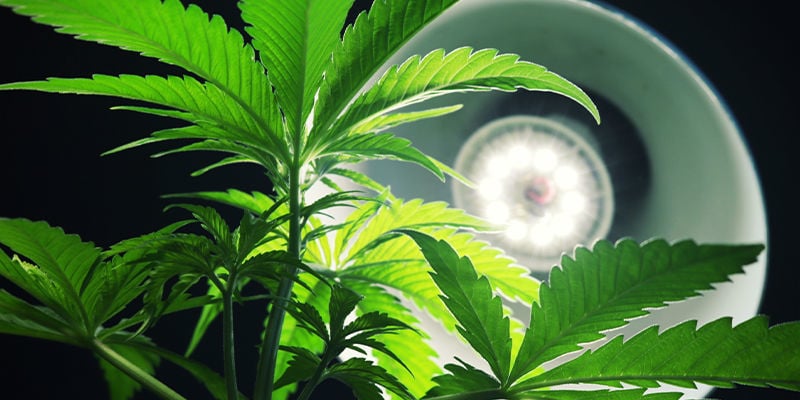
The standard way to set up a lighting fixture in grow rooms or tents is to hang your lights roughly 12–60 inches (30–150cm) above your canopy, depending on what kind of lighting system you're using (HID lamps need to be hung further away as they produce more heat, for example).
Side lighting, however, takes things a step further, delivering direct light to the areas below your canopy, encouraging your plants to produce more bud sites during the vegetative stage, and boosting flower development on the lower parts of your plants during bloom.
Should You Put Side Lights In Your Grow Tent?
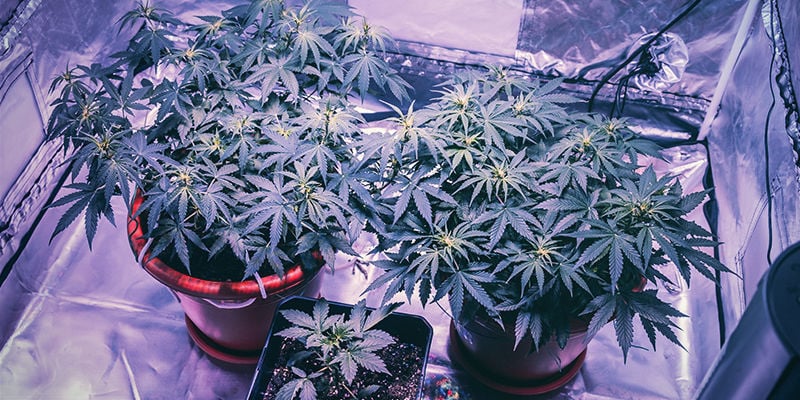
Cannabis is a sun-loving plant that naturally grows best in environments where it receives at least six hours of direct sunlight per day. Basically, the more light cannabis plants receive, the happier and healthier they are.
Unfortunately, replicating the conditions cannabis loves most can be difficult in an indoor space. Because cannabis plants are naturally apically dominant, maximising the light energy produced by your grow lamps is tricky, as most of it lands on the uppermost parts of your plants.
If you’re growing in a small room, tent, or cupboard, for example, you might find that your grow lights struggle to properly penetrate your canopy, leaving you with big flowers on the upper parts of your plants, and small, airy buds below. Some growers deal with this problem by defoliating the lower parts of their plants (removing leaves) to direct energy to the areas that produce the viable buds. Side lighting, however, can be a great alternative.
By providing your plants with extra light from the side, you can distribute more light energy to the areas below your canopy, promoting the development of bigger, more potent flowers in these areas.
What’s the Difference Between Side Lighting and Supplemental Light?
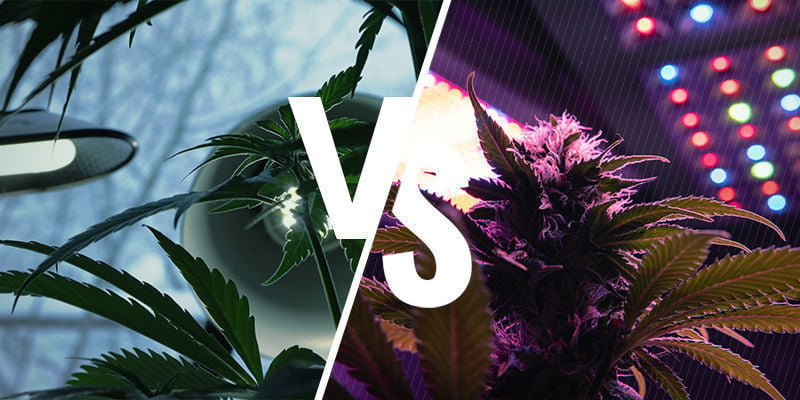
If you’ve researched ways to increase lighting in your grow, you’ve likely read about the idea of supplemental lighting. While both side lighting and supplemental lighting are effective ways to increase the amount of light energy that your indoor plants receive, understanding the fundamental differences between the two is important:
-
Side lighting involves placing lights vertically along the perimeter of your grow space. These lights help to improve yields by delivering more light to the undergrowth and lower bud sites of your plants.
-
Supplemental lighting can refer to any kind of extra lighting used to enhance the amount of photo energy in your grow space, to help manipulate daylight hours in an outdoor garden or greenhouse, or to boost lighting in a particular area of the room/tent.
The Benefits Of Side Lighting For Cannabis
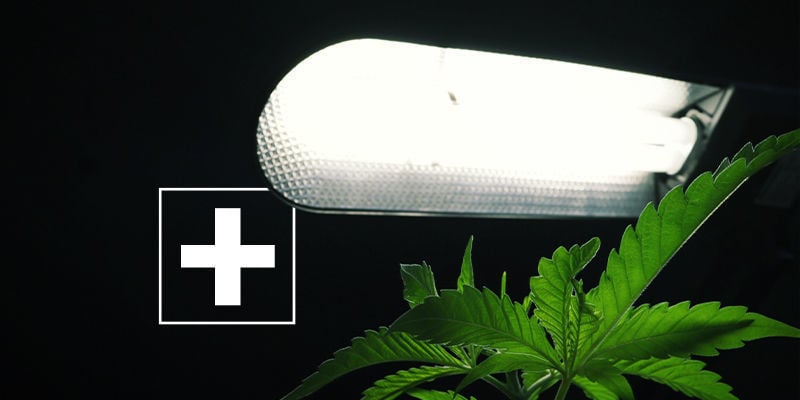
There are many benefits that come from installing side lighting in your indoor grow room or tent, including:
-
During the vegetative stage, side lighting can enhance the development of flowering sites on lower parts of cannabis plants.
-
During the flowering stage, side lighting helps to deliver more photo energy to lower flowers, helping them grow larger and produce more resin.
-
If, for some reason, your overhead grow light isn’t capable of directing enough light across your entire grow space, side lighting can supplement your main lamp and address this issue.
-
Side lighting can help to boost the overall health of your plants.
-
Side lighting can dry out your soil a little faster, which, in turn, can prevent overwatering, as well as pest or mould issues.
How To Set Up Side Lighting For Cannabis Plants?
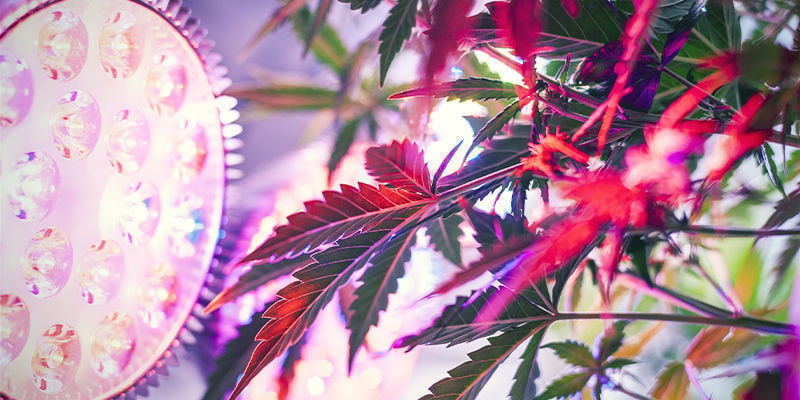
Installing side lighting in your grow tent/room is pretty straightforward; all it involves is installing the lights of your choice (we recommend cooler options like CFLs—compact fluorescent lights—or small LED grow lights) along the perimeter of your grow space.
How exactly you choose to position your lights will obviously depend on the amount of space you have available, the varieties you’re growing, and their morphology. Ideally, we recommend placing your side lights at roughly the same height as the top of your pots. This will ensure the lights direct most of their energy to the lower parts of your canopy; hang them any lower, and you might waste some photo energy on the soil or the base of the stems.
Keep in mind that CFL and HID lights aren’t the most efficient options for growing cannabis, as a lot of the energy they produce is transformed into heat. If you choose to use these types for your side lighting, make sure they are at least 10–12 inches (25–30cm) from your plants to avoid burning them.
That said, we recommend using LED grow lights for your side lighting setup. Not only do LEDs boost the health and development of your plants far above what’s possible with CFLs, but they also don't drive up the temperature to a stressful degree like HIDs.
All in all, LEDs tend to be the modern cannabis grower’s choice for both overhead and side lighting.
Side Lighting Vs Other Growing Techniques
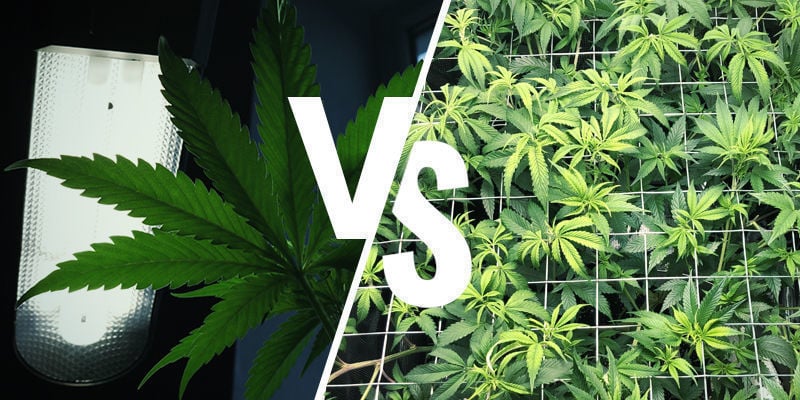
Side lighting can be a great way to boost the health and growth of your marijuana plants. However, there is one big downside to using this method of supplemental lighting; it can greatly drive up the electricity costs of your operation. If you’re growing on a budget, there are other (arguably better) ways to boost the efficiency of your grow lights and increase your yields. These include:
-
LST: Low-stress training is a great, cost-effective way to manipulate the growth of your plants and ensure the light from your grow lamps better reaches the lower parts of your weed plants.
-
Defoliation: Defoliating the lower parts of your plants helps to direct energy to the areas that will produce the biggest, most potent buds.
-
ScrOG: ScrOG is a growing technique wherein you weave the growth of your plants through a mesh screen to form an even, horizontal canopy. This ensures the light from your lamps penetrates all bud sites evenly.
- FIM, Topping, Super Cropping: All of these high-stress techniques make the most of your plant's energy stores, directing resources to sites that’ll produce the best-quality flowers.
Should You Use Side Lighting To Boost Cannabis Yields?
Side lighting can be an effective way to increase your cannabis yields. However, it shouldn’t be your top priority, as the increased running costs can be sizable. Before you think about installing side lights in your room or tent, ensure you're keeping your growing conditions optimal, feeding and watering your plants correctly, and that you’re making use of at least some of the training techniques listed above, as they are far more efficient—and a great learning experience!
-
 6 min
17 January 2022
Using LED Grow Lights To Maximise Cannabis Yields
Choice; a wonderful freedom or a terrible burden? Choosing how to set up your cannabis grow requires a lot of decisions, not least of all when it comes to lighting. Find out all about LED lights,...
6 min
17 January 2022
Using LED Grow Lights To Maximise Cannabis Yields
Choice; a wonderful freedom or a terrible burden? Choosing how to set up your cannabis grow requires a lot of decisions, not least of all when it comes to lighting. Find out all about LED lights,...
-
 5 min
14 September 2021
How To Boost THC With UV Light
Growing cannabis can be good fun, and growers are always looking for that next thing to push their weed to the next level. Well, UV-B light might just be it. Used correctly, you can make your weed...
5 min
14 September 2021
How To Boost THC With UV Light
Growing cannabis can be good fun, and growers are always looking for that next thing to push their weed to the next level. Well, UV-B light might just be it. Used correctly, you can make your weed...
-
 5 min
20 October 2020
The Optimal Distance Between Grow Lights And Cannabis Plants
Hanging a grow light in your grow room or tent is just one part of the story. To really get the most out of your cannabis plants, you need to hang your light at the optimal height to support robust...
5 min
20 October 2020
The Optimal Distance Between Grow Lights And Cannabis Plants
Hanging a grow light in your grow room or tent is just one part of the story. To really get the most out of your cannabis plants, you need to hang your light at the optimal height to support robust...









 United States
United States













